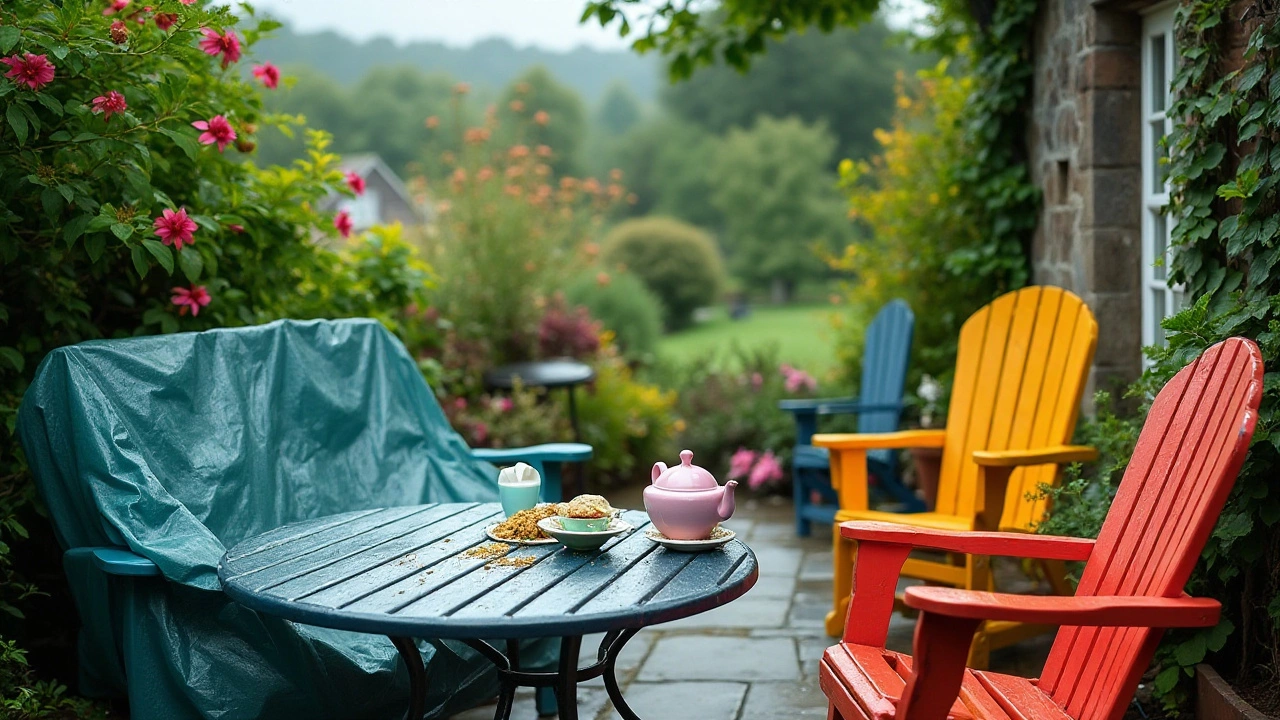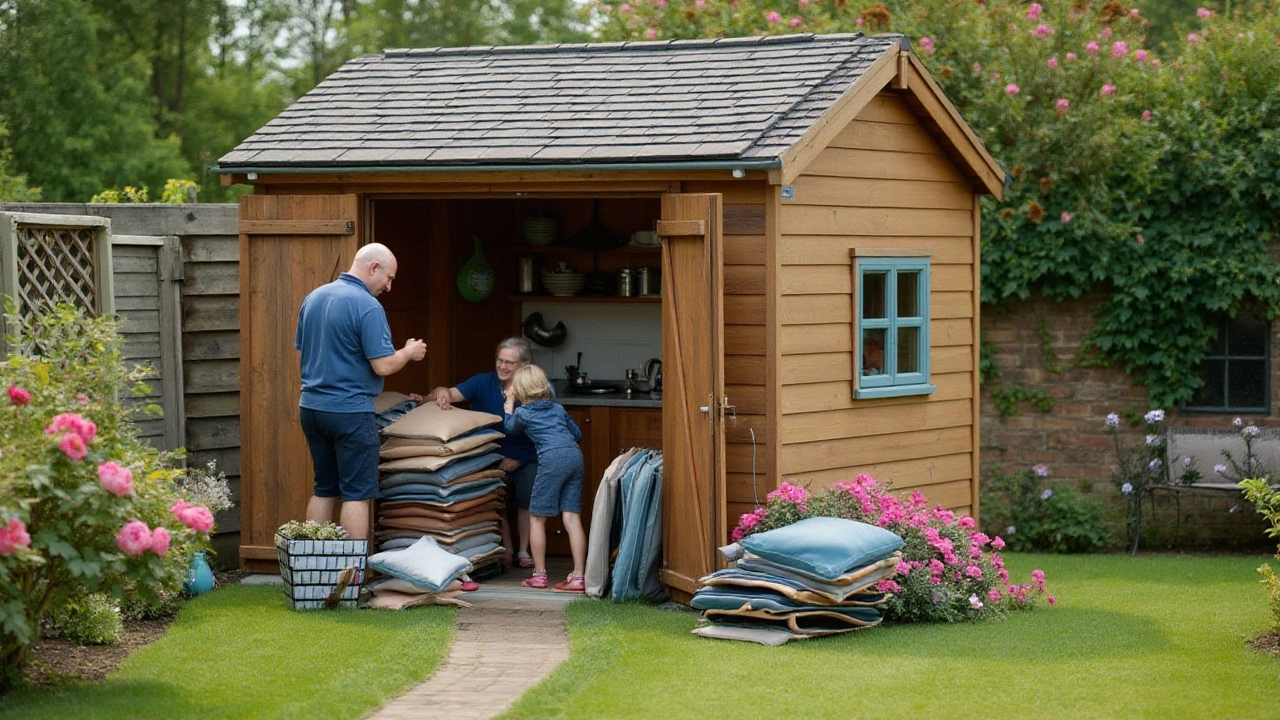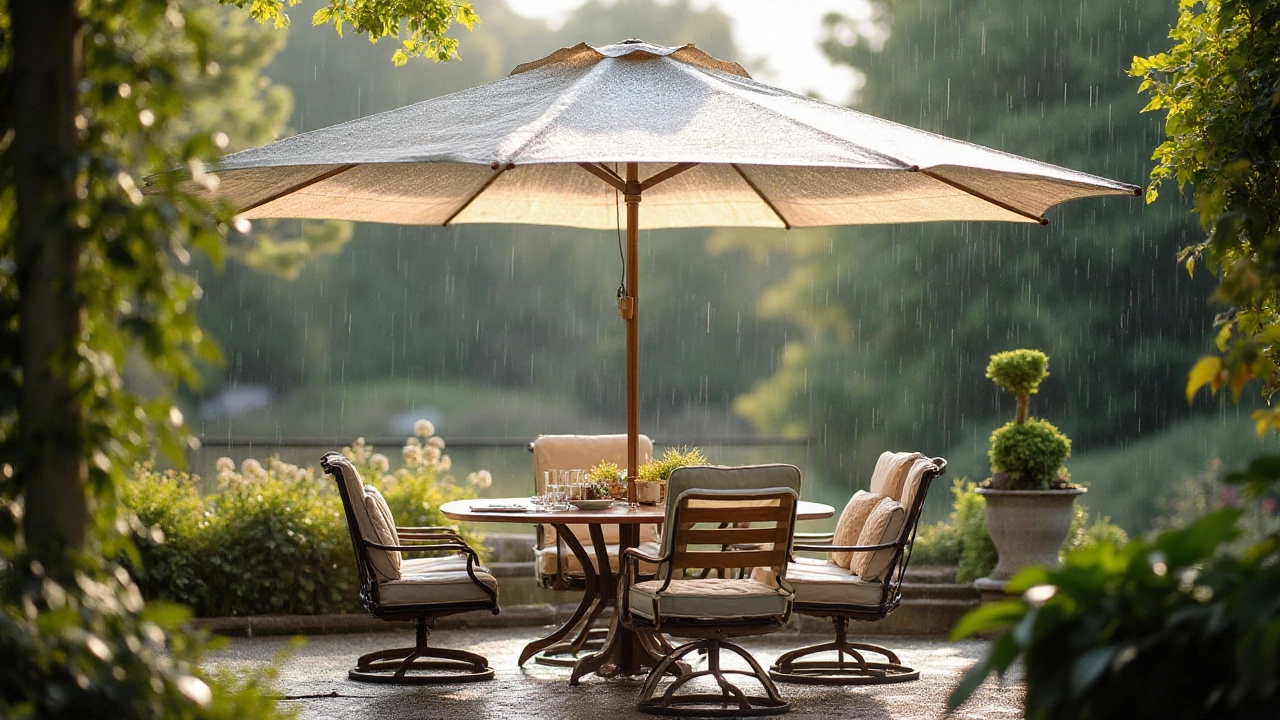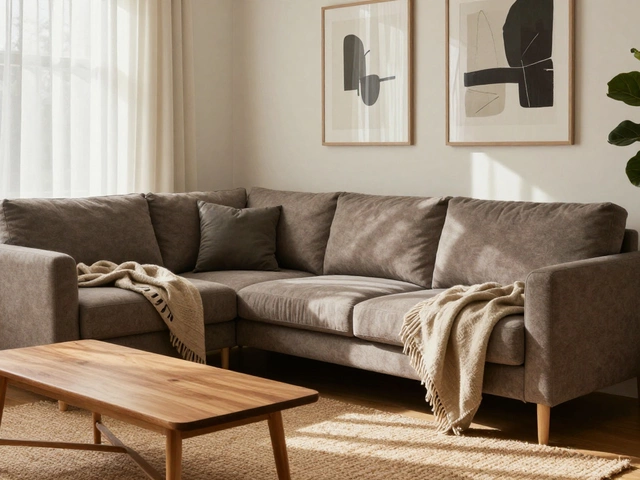 23
Dec,2024
23
Dec,2024
When the skies turn gray and rain begins to fall, one might wonder what happens to their beloved patio setup. The elements can be unkind to outdoor furniture, turning vibrant colors dull and leaving once pristine cushions a sodden mess. But fear not, with a little know-how, your patio can remain untouched by the whims of weather.
Different materials respond uniquely to the challenges of rain, and understanding these differences is the first step to ensuring their longevity. From hardwood tables to metal frames, each requires a unique approach to preserve its life.
If stashing everything away isn’t an option, consider investing in protective covers designed specifically to fend off rain and debris. These covers come in various forms, some offering UV protection, others merely serving to shield against moisture.
- Understanding Material Vulnerability
- Using Protective Covers
- Smart Storage Solutions
- DIY Waterproofing Techniques
- Routine Maintenance and Care
- Incorporating Shelter Options
Understanding Material Vulnerability
When it comes to patio furniture, not all materials are created equal, especially in the face of rain. Each type of furniture, be it wooden, metal, or synthetic, possesses unique vulnerabilities that dictate how it should be treated when rain is on the horizon. Taking the time to understand these differences can mean the difference between lush outdoor settings and deteriorated eyesores. Wooden furniture, particularly those made from softer woods like pine, is susceptible to swelling and warping. When exposed to moisture repeatedly, these woods can lose their shape and structural integrity. Hardwoods like teak or eucalyptus offer more resistance but aren't immune to the damp effects if left untreated. Using oils or sealants can provide a layer of protection, reducing the speed at which water can penetrate, although maintenance must be consistent for this to be effective.
Metal furniture brings a different set of challenges. While aluminum is naturally resistant to rust, iron and steel can succumb to corrosion over time if their coatings become damaged. Regular inspections for chips or scratches can be crucial in preventing rust from taking hold. Reapplying protective coatings or using rust-inhibiting sprays can prolong the life of metal pieces, ensuring they remain a strong presence in your garden.
Meanwhile, synthetic materials like plastic and resin are generally more immune to wet weather woes. They don't rust or rot, making them popular choices for year-round exposure. However, prolonged moisture can lead to mildew or mold, particularly if the furniture isn’t promptly cleaned and dried. Using covers to protect from downpours can help maintain their appearance, even if these materials aren’t as prone to water damage inherently.
An insightful perspective comes from Kate L. Bernhardt, a renowned garden furniture designer, who once said,
"The battle against the elements is one of anticipation. Knowing your furniture's frailties empowers you to protect your outdoor space with ingenuity."With such advice in mind, homeowners can make informed decisions that enhance their outdoor living areas. Understanding these vulnerabilities is not merely about reacting to rain but about proactively ensuring a prolonged lifespan for each investment in outdoor comfort. This knowledge grants us the foresight to address issues before they arise, with protective measures that are as versatile as the furniture itself.
Using Protective Covers
When it comes to extending the life of your patio furniture, using protective covers can make a world of difference, especially in areas prone to unpredictable weather. Investing in high-quality covers is quite literally a shield of armor against rain, keeping your furniture dry while also protecting it from dust, bird droppings, and UV rays during sunnier days. Not all covers are created equal; thus, understanding the different materials they are made from is crucial. Polyester, vinyl, and canvas are the most common options, each offering unique benefits. Polyester covers, for instance, are known for their strength and resistance to shrinkage and stretching, making them a durable choice. Vinyl, on the other hand, is applauded for its water resistance, though it’s important to ensure that it has a soft inner layer to prevent scratches on wood or glass surfaces. Canvas, particularly when it is treated for water resistance, offers a breathable option, helping prevent the build-up of mold or mildew underneath.
When selecting covers, size matters. It’s advisable to measure your garden furniture carefully, ensuring the covers fit snugly to avoid flapping or blowing away in high winds. Some covers come with handy tie-downs or elastic hems to provide added security. Additionally, many covers offer added features like ventilation flaps. These are particularly useful because they equalize the air pressure and reduce condensation, a common issue when dealing with rain. Another smart option is covers with integrated handles or zippers, which make it easier to remove them when the sun comes back. Some homeowners go a step further by choosing custom-made covers tailored to their specific furniture pieces, ensuring a perfect fit and enhanced protection.
According to a study published in the Journal of Cleaner Production, “prolonging the life of consumer products via the use of protective covers can significantly reduce the environmental footprint by mitigating the frequency of replacements.” The initial vibe might feel like a big investment, but in the long run, quality covers save both money and hassle, while also being kinder to the planet. Finding these sustainable solutions enhances not just the longevity of your furniture but aligns with broader eco-friendly practices.
Maintenance of these protective covers should not be overlooked. Regular cleaning helps maintain their effectiveness and appearance. Dirt and grime can degrade the material over time, so it’s recommended to clean the covers periodically with a mild soap and water solution, ensuring they are completely dry before being returned to service. Storage is another vital consideration; when not in use, keep the covers in a cool, dry place, free from rodents or insects that could damage them. By being mindful of these tips and insights, your outdoor setup remains pristine, ready to offer comfort and style at a moment’s notice, regardless of the weather.

Smart Storage Solutions
When dealing with patio furniture, storage solutions are crucial, especially when the forecast calls for inclement weather. An optimized approach to storage ensures that your outdoor setup is ready to face the elements without suffering any detriment. The key is to develop a system that is both accessible and effective, making it possible to protect your items at a moment’s notice.
For those with ample space in their garages or sheds, placing large items like tables and chairs indoors is always a beneficial move. But space can be a luxury not everyone enjoys. If moving furniture inside isn’t an option, consider purchasing a sturdy outdoor storage shed. These structures come in various sizes and materials, often offering excellent protection against harsh weather. Look for models made from robust, waterproof materials with adequate ventilation to prevent mold or mildew growth, as dampness can be just as damaging as the rain itself.
Another ingenious solution is the use of deck boxes, which can double as a seating area when not in use. These boxes are ideal for storing cushions and small decor items. Opt for models with tight-sealing lids to ensure no moisture can sneak in. Many of them are crafted from durable, water-resistant plastics like polyethylene, making them a practical choice for rain protection.
Some homeowners have found innovative ways to convert existing space into smart storage solutions. Don’t overlook areas like under-deck spaces or within gazebos, which can be easily converted into hiding spaces for your garden furniture. These areas naturally offer some protection, and with a few modifications – like adding retractable awning or sturdy tarps – they can serve as a temporary shelter for your outdoor goods.
According to a recent survey by Outdoor Living Trends, 56% of homeowners have turned to multipurpose furniture with hidden storage as a strategy to manage their outdoor items effectively.
Lastly, bringing versatility into play with collapsible or foldable furniture is always a smart choice. Many manufacturers design patio furniture that can be easily folded or collapsed, saving space and making it easier to store. Not only does this facilitate easy storage, but it also encourages quick setup once the rain has passed.
By creatively utilizing your available space and choosing the right storage options, you can ensure that your patio setup remains in top notch condition, ready for sunshine as soon as the weather permits. Embracing these strategies not only extends the life of your outdoor care items but also helps maintain their aesthetic appeal for seasons to come.
DIY Waterproofing Techniques
Protecting your patio furniture from the unforeseen downpour doesn't always require professional intervention or costly equipment. Indeed, even a novice can successfully employ do-it-yourself waterproofing methods to safeguard outdoor pieces from the relentless assault of rain. The first step is to understand the inherent properties of the materials your furniture is made from. Different materials call for different protective measures, and making use of the right technique can prolong the life of your patio setup significantly.
For instance, wooden furniture is often prone to absorbing moisture, leading to swelling and, eventually, decay. To combat this, you can apply a coat of waterproof sealant or wood preservative, specially formulated to repel water and prevent fungal growth. A popular choice is marine varnish, which is designed to withstand the harshest marine environments—perfect for ensuring your garden furniture can weather a storm in style. It's important to sand the wood before application to ensure smoothness and optimum adhesion of the sealant.
On the other hand, wrought iron or metal pieces require their own type of care. Though often more resistant to water than wood, metal can still suffer from rust if left exposed. Begin by thoroughly cleaning the metal with a mild soap and water solution, removing any existing rust with sandpaper. After drying, apply a rust-inhibiting primer followed by a coat of rust-resistant paint specific to metal surfaces. According to an article in Home Maintenance Journal, "preparing your metal furniture with a thorough clean and protective coatings can extend its life by several years."
For fabric components such as cushions or umbrella covers, a hydrophobic spray protector is invaluable. These products create an invisible shield on fabrics, causing water to bead off rather than soaking in. Ensure the fabrics are clean and dry before you apply the spray evenly. Allow sufficient drying time, as indicated on the product label, before reuniting them with your furniture set. Reapplying twice a year, typically at the start of spring and fall, can guarantee maximum resistance to water. The American Homeowners Association notes that "engaging in routine maintenance and protection of fabric elements can conserve their vibrancy and durability over time."
For those interested in natural solutions, boiled linseed oil can work wonders on wooden furniture. Its natural properties allow it to penetrate deeply, creating a durable water barrier. Dilute the oil with equal parts mineral spirits for faster drying and better penetration. Apply generously using a cloth, allowing it to soak in before wiping away excess. Repeat periodically to maintain the layer of protection. This method offers an eco-friendly alternative, ideal for those who prefer avoiding synthetic chemicals.
Incorporating these techniques as part of your routine care not only ensures your furniture remains attractive but also sustains its functionality season after season. That being said, it’s also beneficial to understand climatic conditions in your geographical area, as some regions may require more frequent applications than others. By taking these straightforward yet effective steps, you can rest assured that your outdoor furniture will withstand whatever Mother Nature throws its way, leaving you free to enjoy the serenity of your garden without worry.

Routine Maintenance and Care
Attending to your patio furniture regularly can make all the difference in weathering the storm—literally. Routine maintenance and care of your furniture not only enhances its durability against the elements but also maintains its aesthetic appeal. Begin with understanding the specific needs of the material your furniture is made from. Wood, for instance, often requires seasonal oiling and sealing to prevent drying out and cracking under harsh weather conditions. On the contrary, metal pieces should be routinely inspected for rust, addressing any sign of corrosion immediately to prevent further damage.
If you’ve got garden furniture made from wicker, keeping it clean and free from debris is important as dust and moisture can get trapped in the crevices. Use a soft brush and a mild soapy solution to gently scrub away buildup. Synthetic wicker can handle a more rigorous wash, even sprayed down with a garden hose if needed, but natural wicker appreciates a lighter touch to keep its integrity intact. Meanwhile, fabrics and cushions should be treated with water-repellent sprays to enhance their resistance to moisture.
"Taking care of your outdoor furniture isn’t just an annual affair; it requires periodic attention to detail," recommends Betty Jenkins, a home and garden specialist. "Keep a schedule that matches the material and lifestyle demands you have."
When maintaining outdoor care items, sometimes prevention is the best solution. If access to storage is limited, spot-check your furniture for signs of wear that might worsen when exposed to rain. Applying sealants or protective oils twice a year can profoundly affect the longevity of certain types of furniture. Invest in high-quality protective covers that are breathable and efficient in keeping moisture at bay, and always allow fabrics to dry thoroughly before covering them to prevent mold and mildew.
Another key factor in extending the life of your patio setup is maintaining its visual and structural appeal. Beyond basic cleaning, consider carrying out small repairs whenever possible, such as tightening screws and bolts. These simple adjustments can prevent a minor issue from becoming a major one. Consider compiling an inventory of cleaning products suitable for various materials to avoid harmful chemicals that might worsen the condition of your furnishings. A knowledgeable approach to cleaning supplies not only safeguards your furniture but also better aligns with environmental considerations.
To motivate upkeep, imagine your patio as an extension of your home. It may serve as a haven for solace or a social gathering space. Such areas deserve the same care and attention. Regular maintenance might not only save money in the long run by reducing the need for replacements, but it also guarantees you'll enjoy your outdoor oasis rain or shine. Remember, patio furniture isn't ordinary furniture; it is a lasting investment in comfort and style.
Incorporating Shelter Options
For those with a passion for outdoor living, creating a sheltered patio environment is about more than just practicality; it's an art form. Shelter from the rain not only helps preserve your beloved patio furniture, but it also adds an inviting dimension to your outdoor space, offering protection from both drizzles and the harsh midday sun. One simple yet effective addition is a pergola, which provides a sturdy structure that can support vines or hanging plants, adding a beautiful aesthetic while keeping rain at bay. However, not everyone has the space or budget for permanent structures, and this is where temporary shelters like awnings or umbrellas can play a crucial role, offering flexibility and ease as you protect your outdoor treasures whenever needed.
Retractable awnings provide an efficient solution with the added benefit of control; you can easily cover your patio when showers are forecasted or retract it to bask in the sun's warmth on clear days. They come in various styles and sizes, allowing you to tailor your choice to match the specific needs of your outdoor furniture. Pop-up canopies are another fantastic option, especially for those who desire mobility and simplicity. Easily assembled and dismantled, they allow you to protect your furnishings in a moment's notice, an excellent choice for renters or frequent movers.
Even among these modern solutions, there's room for creativity. By using tarpaulins creatively, you can construct makeshift shelters that cost little but deliver high on functionality. Securing a tarp over a few strategic points to extend coverage can be a quickfix; though, it's always wise to invest in quality materials to ensure resilience against the elements. Quoting one well-known landscape designer,
"A well-designed shelter not only protects but transforms your patio into an all-season haven."These options reflect the flexibility and ingenuity available to modern homeowners, showing that, with a bit of effort, every patio can offer comfort and protection regardless of the weather outside.
Statistically, homeowners who incorporate durable shelters reported a 35% increase in the lifespan of their garden furniture, a notable fact that underscores the importance of taking proactive measures. Shelter options do more than just block rain; they create a cozy outdoor oasis and, when done right, promise years of enjoyment without the incessant worry about weather damage. So, whether it's investing in a custom canopy or fashioning a simple, cozy nook on your porch, the right shelter solution can indeed make a difference, transforming your patio into a cherished retreat.




